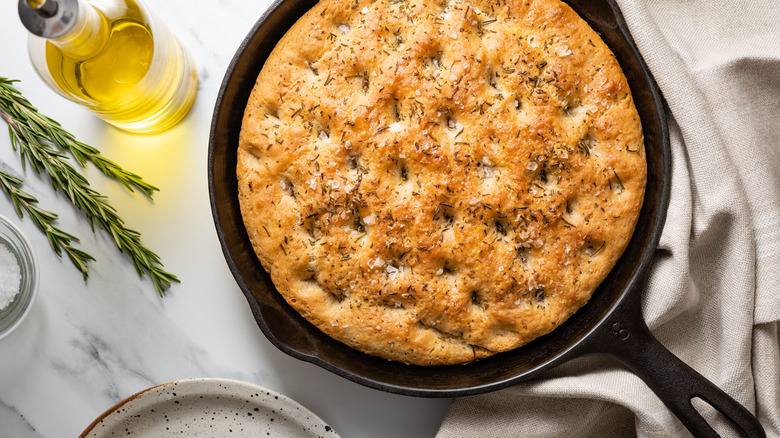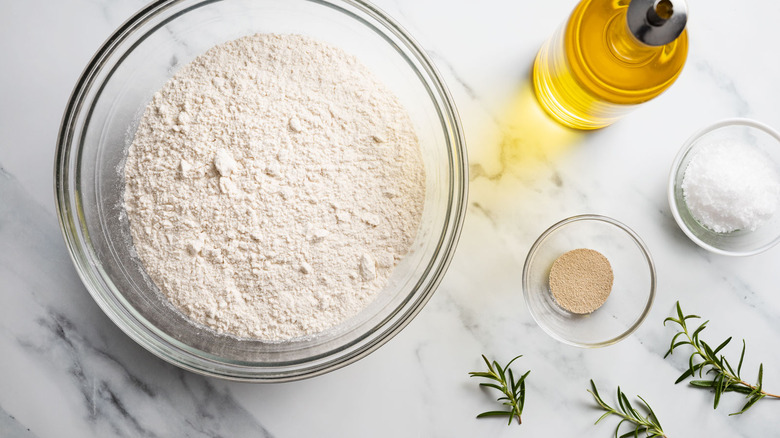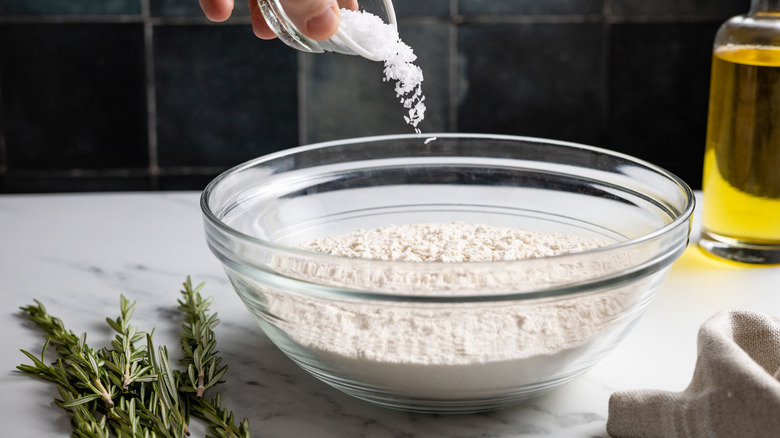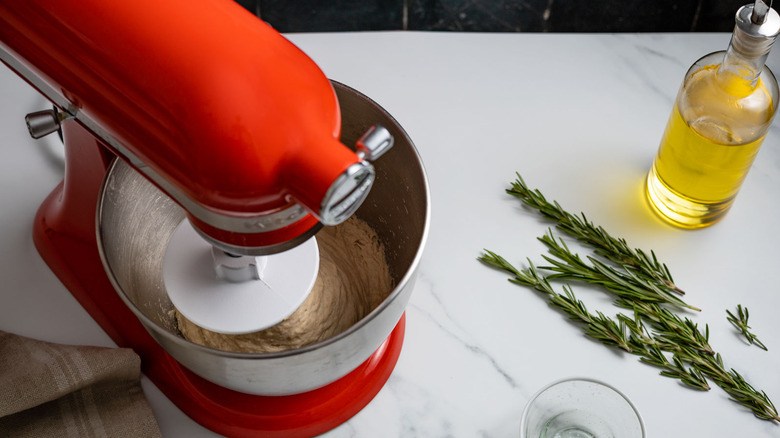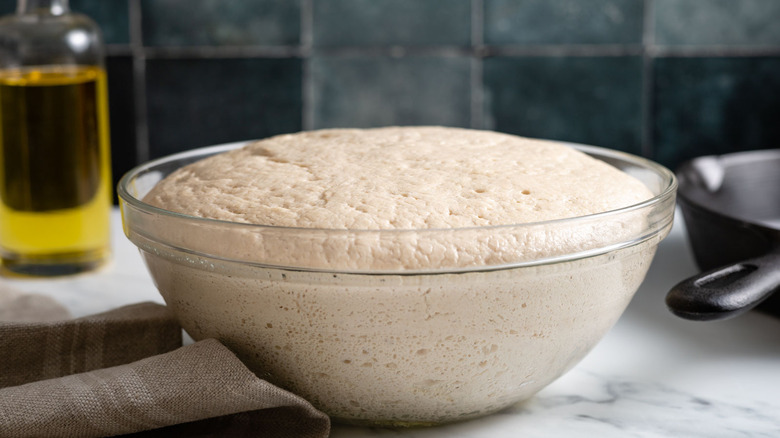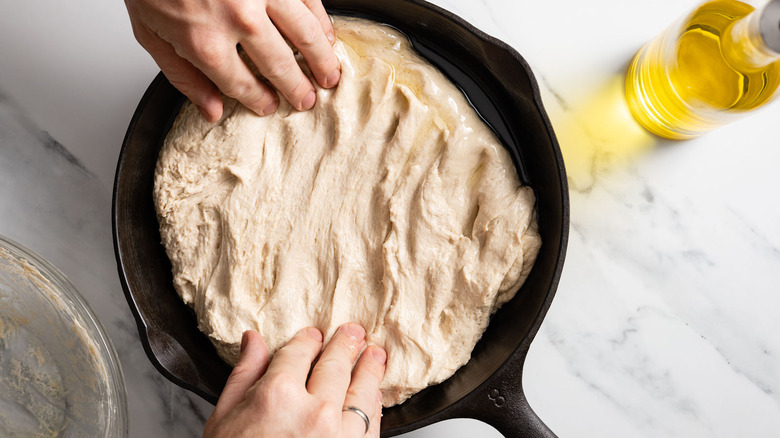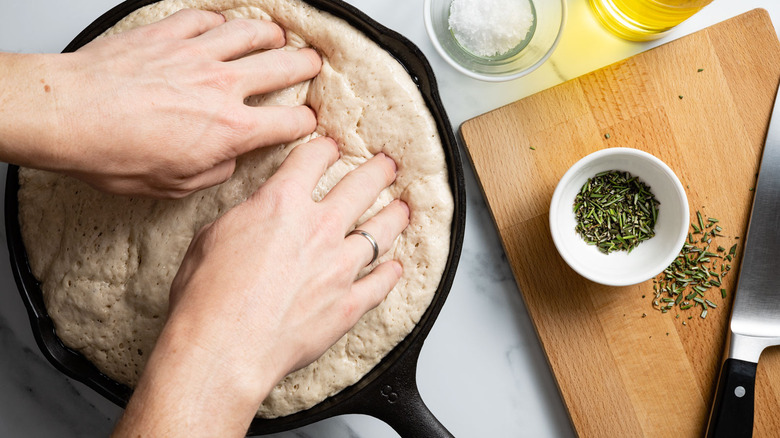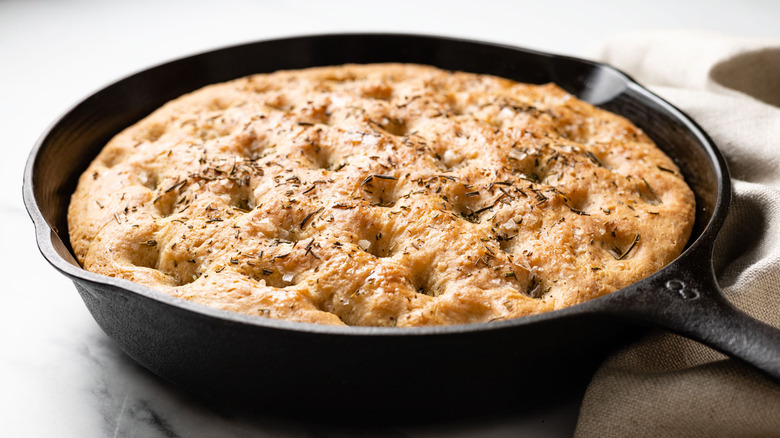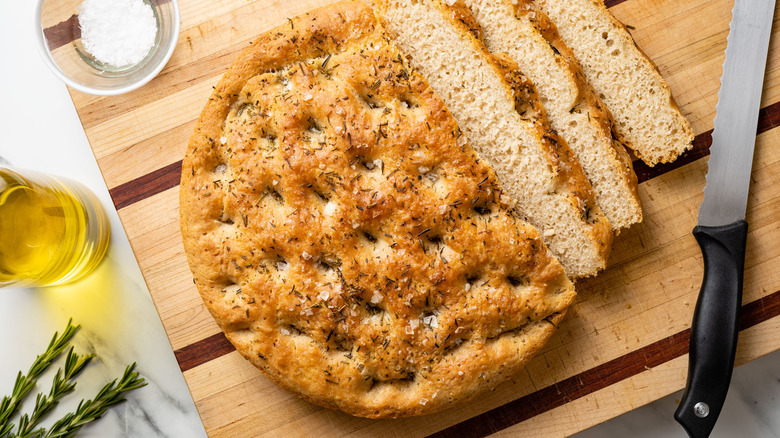Authentic Italian Focaccia Bread Recipe
Any kind of bread is welcome as far as we're concerned, and authentic Italian focaccia is high on our list of favorites. Recipe developer Mark Beahm, the face and blogger behind The Sunday Baker, is no stranger to baked goods. As a matter of fact, since he started baking, thanks to his mother and grandmother, he has explored culinary specialties from countless cultures. He is especially fond of rustic European baking, which is no surprise once you follow his recipe for authentic Italian focaccia. Beahm remarks, "It's a rustic bread that's perfect for tearing into." He is particularly keen about the texture, and describes it while noting the contrasts. "The crust is crisp and full of flavor from the olive oil and flaky salt. The interior is soft and chewy."
Baking your own focaccia might seem like a task best left to professionals, but Beahm patiently walks you through the steps. There's nothing like biting into a freshly baked focaccia, so having to wait for a few hours is totally worth it. Although this recipe takes a bit of time to complete, most of the prep time will be spent waiting for the dough to rise. You can use that time to tend to other items on your to-do list, then sit back and wait for the unbeatable aromas of freshly baked focaccia.
Gather the ingredients to prepare this authentic Italian focaccia bread
If you're a bit intimidated by the prospect of making your own focaccia, you'll feel more comfortable with the short ingredient list. First of all, you'll need bread flour, which is described by Bon Appétit as having a greater protein and gluten content. More importantly, these elements produce a satisfyingly chewy texture which makes the focaccia especially pleasant. Beahm remarks, "You can substitute all-purpose flour for the bread flour, but the bread won't have the same texture and chew." If you're planning on making bread more regularly, you may want to have both options available in your pantry.
Next, you'll need flaky sea salt for the dough and to top the focaccia before baking. Aside from enhancing flavors, The Weekend Bakery noted that salt actually helps create more volume in your dough. Instant yeast can be added directly to dry ingredients, which makes it a convenient option. Water is essential, since it blends with the flour to create dough. When making focaccia, a generous dose of olive oil contributes to the tender flaky crust and the rich flavor.
Finally, Beahm chooses to top this authentic Italian focaccia with rosemary, a classic choice. Nonetheless, he confirms, "You can make focaccia with all kinds of toppings: tomatoes, cheese, caramelized onion, roasted garlic, potato, you could even make a thick crust pizza with it." What will you start with? It's prime time to let your creativity shine!
Whisk the flour, salt, and instant yeast in a stand mixer bowl
Set out your stand mixer, and make sure that it is fitted with the hook attachment. Pour the bread flour, 1 tablespoon of flaky sea salt, and the instant yeast into the bowl, and whisk everything together to combine. This step helps distribute the yeast and the salt evenly throughout the flour. This helps achieve consistent flavors and a dough that rises uniformly.
Add the water and olive oil to the flour, then knead the dough for five minutes
Next, pour the water into the stand mixer bowl, and add 2 tablespoons of olive oil. Knead the contents together on medium speed for five minutes, or until the dough develops a smooth and elastic consistency. Beahm points out, "The dough for focaccia is very wet and sticky." Nevertheless, he warns to leave the dough as-is, explaining, "It might be tempting to add more flour, but the texture depends on the high hydration." Keeping the dough wet and humid "makes for a better crumb and a crisper crust," according to Beahm.
Cover the dough, and let it rise until it has doubled in size
Stretch out some plastic wrap to cover the bowl of dough, and let it rise at room temperature. Beahm recommends waiting an hour and a half or as long as it takes for the dough to double in size. By allowing the dough to properly rise, the final focaccia will be light and airy, so it's truly worth it to kick back and be patient.
Transfer the dough to a cast-iron skillet, and let it double in size again
Once the dough has suitably risen, pour 2 tablespoons of olive oil into a 10-inch cast-iron skillet or round cake pan. Beahm advises, "Make sure the pan is coated all around with plenty of olive oil before transferring the dough." If it isn't sufficiently oiled, "the bread may stick to the pan, making it difficult to get out after baking." Aside from practical reasons, Beahm adds, "The olive oil also helps crisp the bottom of the focaccia."
Transfer the dough from the bowl into the greased pan, and gently spread it with your fingers so that it fits the surface. Aim to guide the dough towards the sides, but Beahm says, "It doesn't need to go right to the edges, as it will expand during the second rise."
Again, cover the pan with plastic wrap, and leave the dough to rise for another hour and a half, or until it doubles in size. At this point, Beahm describes, "The dough should be puffy with bubbles at the surface."
Press your fingers into the dough to create dimples, then add the toppings
Preheat the oven to 450 F. Dampen your fingers lightly with some water to prevent the dough from sticking, and press them into the dough to create dimples. Food blog Thyme and Envy explained that dimpling the dough helps it rise slowly, and it provides a greater amount of surface area for olive oil, which adds flavor. Go ahead and drizzle the remaining tablespoon of olive oil over the dough. Top it off with the rest of the flaky sea salt and the chopped rosemary.
Bake the focaccia in a preheated oven for 25 to 30 minutes until the top is golden
Your oven should be preheated at this point, so it's time to pop the pan onto a rack, and bake the focaccia for 25 to 30 minutes. You'll know it's ready when the top is golden brown and the bottom has become crisp. Once it's ready, remove the focaccia from the oven to avoid drying out the soft interior. Get ready for your kitchen to fill up with such a lovely aroma!
Let the focaccia cool down before slicing and serving
Let the focaccia cool down in the pan for five minutes, then transfer it to a cooling rack for at least 10 minutes before slicing into it. Focaccia is delicious alone, but for a complete meal, Beahm notes, "I like to serve focaccia as a side for soup, or pasta." Otherwise, if you're tired of regular sliced bread, he remarks, "It's also really good sliced in half to make sandwiches."
You'll want to eat this as soon as possible — and it will be hard not to! Beahm notes, "Focaccia is definitely best the same day it's baked, but it can keep at room temperature for up to two days, wrapped in plastic." In case you want that fresh out of the oven warmth, he says, "You can reheat it in a 375-degree oven for about 10 minutes to crisp it back up."
Authentic Italian Focaccia Bread Recipe
There's nothing like biting into a freshly baked focaccia. This recipe is chewy and full of flavor, thanks to the olive oil and flaky sea salt.
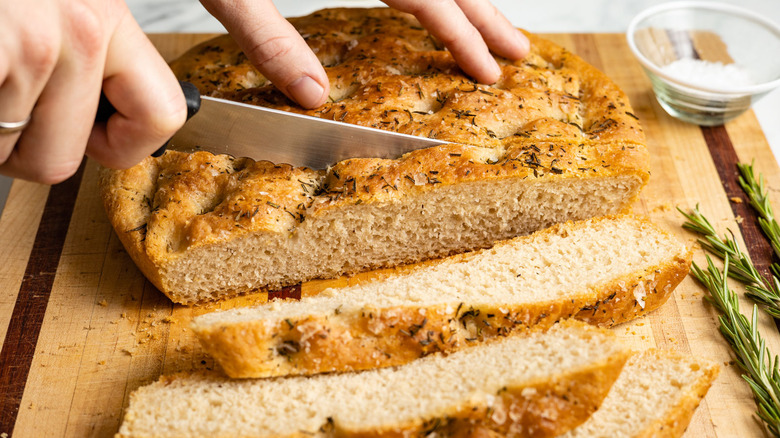
Ingredients
- 4 cups bread flour
- 1 tablespoon + ½ teaspoon flaky sea salt, divided
- 1 teaspoon instant yeast
- 1 ½ cups lukewarm water
- 5 tablespoons olive oil, divided
- 1 tablespoon fresh rosemary, coarsely chopped, for sprinkling
Directions
- In the bowl of a stand mixer fitted with the hook attachment, whisk together the bread flour, 1 tablespoon of sea salt, and the instant yeast to combine.
- Pour in the water and 2 tablespoons of olive oil, and knead on medium speed for 5 minutes, or until the dough is smooth and elastic.
- Cover the bowl with plastic, and let it rise at room temperature for an hour and a half, or until the dough has doubled in size.
- Pour 2 tablespoons of olive oil into a 10-inch cast-iron skillet or round cake pan, and spread it over the entire surface and up the sides.
- Transfer the dough to the pan, and gently stretch it to fill the pan.
- Cover the pan with plastic, and let it rise at room temperature for an hour and a half, or again until the dough has doubled in size.
- Preheat the oven to 450 degrees Fahrenheit.
- Lightly dampen your fingers with water to prevent sticking, and press them into the dough to make dimples.
- Drizzle the remaining 1 tablespoon of olive oil over the top of the dough.
- Sprinkle the remaining ½ teaspoon of flaky sea salt and the rosemary evenly over the dough.
- Bake the focaccia for 25 to 30 minutes, or until the top is golden brown and the bottom is crisp.
- Let the focaccia cool in the pan for 5 minutes, then transfer it to a wire rack, and let it cool for at least 10 minutes before slicing.
- Serve the focaccia warm or at room temperature.
Nutrition
| Calories per Serving | 324 |
| Total Fat | 9.6 g |
| Saturated Fat | 1.3 g |
| Trans Fat | 0.0 |
| Cholesterol | 0.0 mg |
| Total Carbohydrates | 49.9 g |
| Dietary Fiber | 1.8 g |
| Total Sugars | 0.2 g |
| Sodium | 283.9 mg |
| Protein | 8.4 g |
